Chapter Four
1943
By the beginning of 1943, Panzerja¨ger and PaK units were employed on various sectors of the Eastern Front and were heavily embroiled in fierce fighting. Through the first half of 1943 the Germans more or less maintained the strategic initiative on the Eastern Front and guns like the 5cm PaK 38, 7.5cm PaK 40, 7.5cm PaK 97/38, and 7.62cm PaK 39(r) were being extensively used. Yet, despite this array of anti-tank weapons, the Germans knew they had been caught out. In the early part of the war they had created a powerful Panzerwaffe capable of independent strategic operations but had devoted little attention to stopping tanks. Now three years later and in the depths of the Soviet Union, its forces had found themselves hard pressed against modern Soviet armour. German troops now clamoured for more anti-tank firepower.
Thus, during the first half of 1943 the PaK 43 (Panzerabwehrkanone and Panzerja¨gerkanone) came off the Krupp production line. The PaK 43 was the most powerful anti-tank gun of the Wehrmacht so far to see service in significant numbers. It was relatively easy to produce: the carriage was a collection of modified stock components; the trail legs for the weapon were customised from the 10.5cm leFH 18 artillery gun; the wheels were taken from the 15cm sFH howitzer; and the saddle was a steel-plate fabrication that bolted everything together. The gun was fitted with a semi-automatic vertical breech mechanism that greatly reduced recoil. It could also be fired electrically while on its wheels. It had a very flat trajectory out to 914m, making it easier for the gunner to hit targets at longer ranges as fewer corrections in elevation were required. The weapon had outstanding penetration and could destroy the frontal armour of any Allied tank, even at longer ranges. It could even defeat the Soviet IS-2 tanks.
Due to the success of the PaK 43 the Germans were eager to fix it to a tank and modify it into a Panzerja¨ger. The need for new-generation tank hunters was now desperate. By mid-1943 the Nashorn was produced and the PaK 43 was mounted on the chassis of Pz.Kpfw.III and IV tanks. The vehicle was given numerous official designations, such as 8.8cm PaK 43 (L/71) auf Fahrgestell Panzerkampfwagen III/IV (Sf) or 8.8cm PaK 43 (L/71) auf Geschützwagen III/IV (Sd.Kfz.164); it was also designated as the Panzerja¨ger Hornisse.
Another Panzerja¨ger to enter service around this time was known initially as the Ferdinand (after its designer Ferdinand Porsche) and later the Elefant. It was fitted with the powerful 8.8cm PaK 43/2 (early designation 8.8cm StuK 43/1) and was mounted on the chassis of a Tiger tank.
Both of these Panzerja¨ger saw their debut in July 1943. Much hope was hinged on these new modified vehicles to support both panzer and infantry during the German summer offensive of 1943, Operation Zitadelle.
However, within two weeks of the operation, the Red Army had repulsed the German forces with considerable losses. In August, soon after the German failure at Kursk, the Red Army counterattacked towards Orel and Kharkov and launched a massive attack against Army Group Centre. For nearly three months the Russians fought a series of heavy clashes against the Centre and managed to recapture Smolensk and the rail junction at Nevel, forcing back the Germans on a broad front. The Russian attack only faltered in the Vitebsk–Orsha–Mogilev area where almost impregnable lines of defences had been erected by the Germans.
Elsewhere on the Eastern Front, Red Army assaults caused severe losses to the Wehrmacht, Waffen-SS and Luftwaffe, but the Germans managed to hold them back for the time being. Heavy PaK guns and vehicles like the Marder, Nashorn and the Ferdinand helped fulfil the German objective of quickly providing mobile anti-tank firepower, thereby buying Germany time to hold and prepare their lines.
Operations against the Red Army, however, were hampered by stiff resistance and the great distances involved in making war in Russia. As the autumn approached losses mounted and shortages in manpower and weaponry were once again dire.

German troops inspect a knocked-out Russian 45mm M1937 or M1942 anti-tank gun. The Germans often reused these guns on the carriages of PaK 35/36 and re-barrelled them to fire more effective high explosive rounds. The anti-tank guns were known as the 4.5cm PaK 184(r) and PaK 184/1(r).
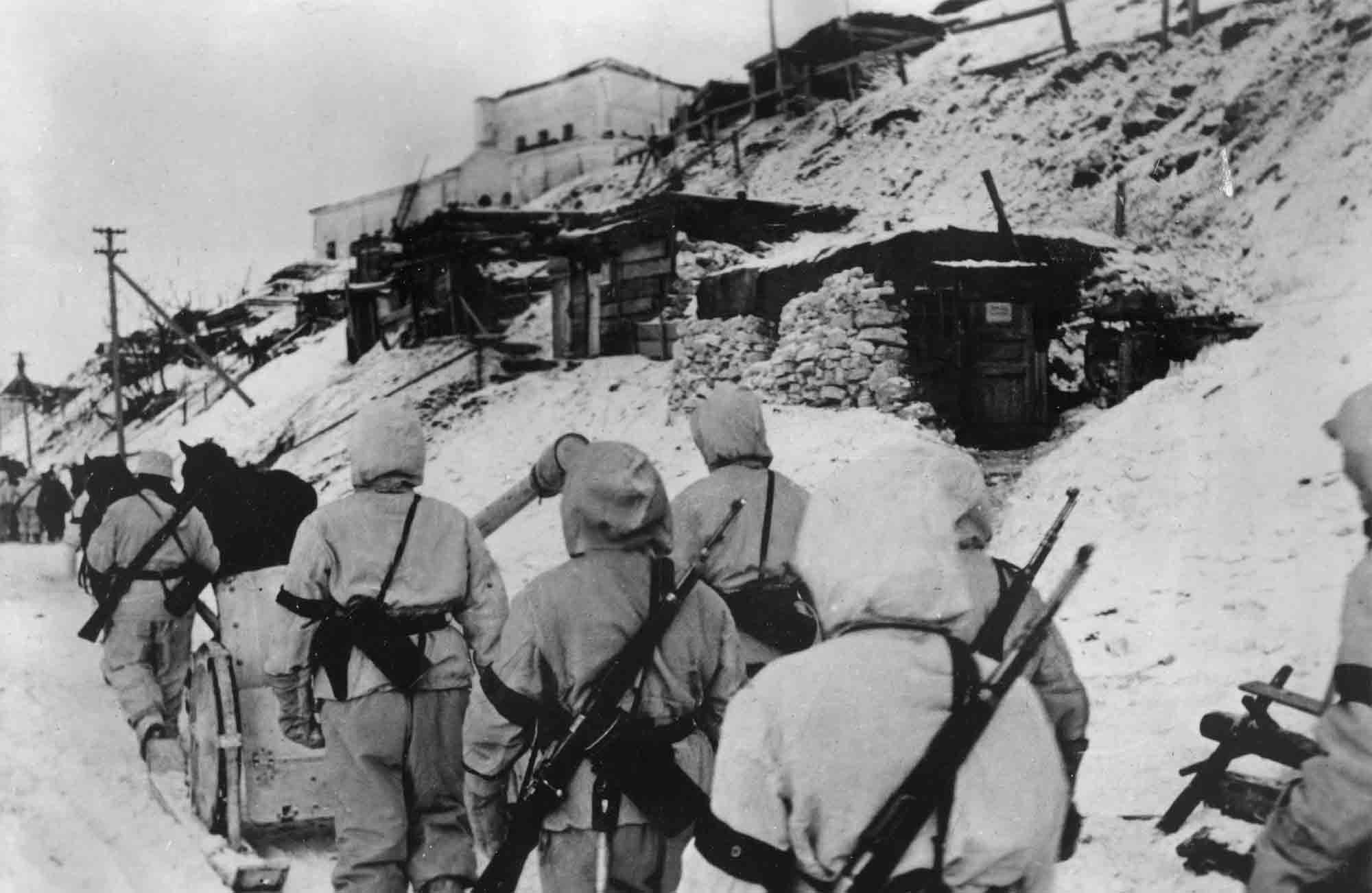
An interesting photograph showing 7.5cm PaK 97/38 gunners during winter operations in early January 1943. Note that the wheels of the weapon have skids on them to slide across the snow quickly enabling the crew to move the gun from one fixed position to another. The gun is being hauled by animal draught.

The crew of a 7.5cm PaK 40 during a fire mission inside a town during winter operations. This gun was designed to fire the same low-capacity APCBC, HE and HL projectiles that had been standardised for use in the long barrelled Kampfwagenkanone (KwK) 40 tank-mounted guns of mid-war and later variants of the Pz.Kpfw.IV tanks.
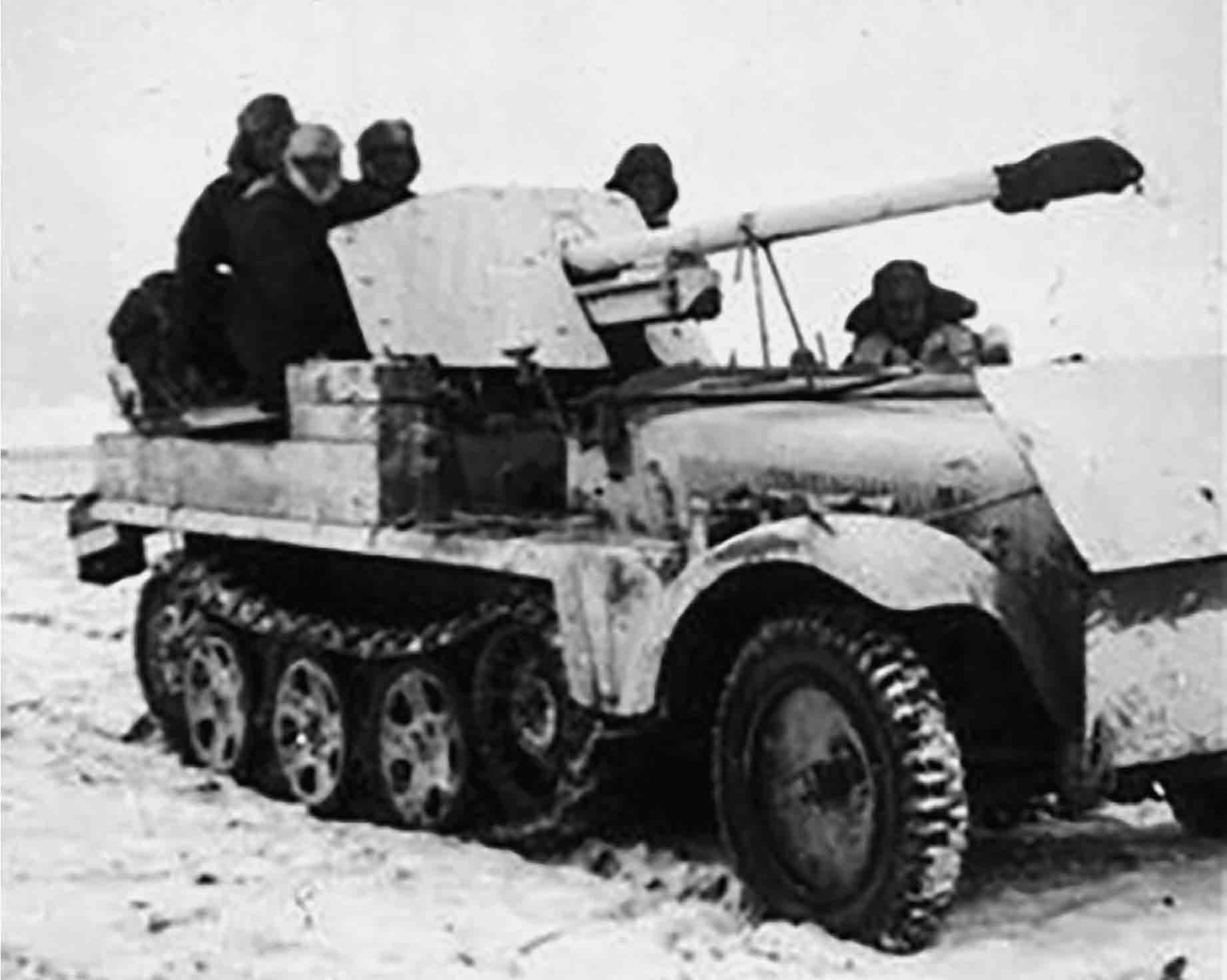
A whitewashed Sd.Kz.10 halftrack with a mounted 5cm PaK 38 on the advance towards the battle-front in early winter 1943. At this period of the war the Germans were up-gunning, converting and modifying their anti-tank guns to deal with the ever increasing threat of enemy armour.

Waffen-SS ‘Totenkopf’ PaK gunners with their weapon during a pause in operations in what was known as the Third Battle of Kharkov in February/early March 1943. The German victory at Kharkov had come at a heavy price in blood: some 12,000 soldiers were killed.

This photograph was taken after the capture of Kharkov in March 1943. It shows an Sd.Kfz.251 halftrack with a mounted PaK 35/36 gun. Note the national flag draped over the front of the vehicle for aerial recognition.
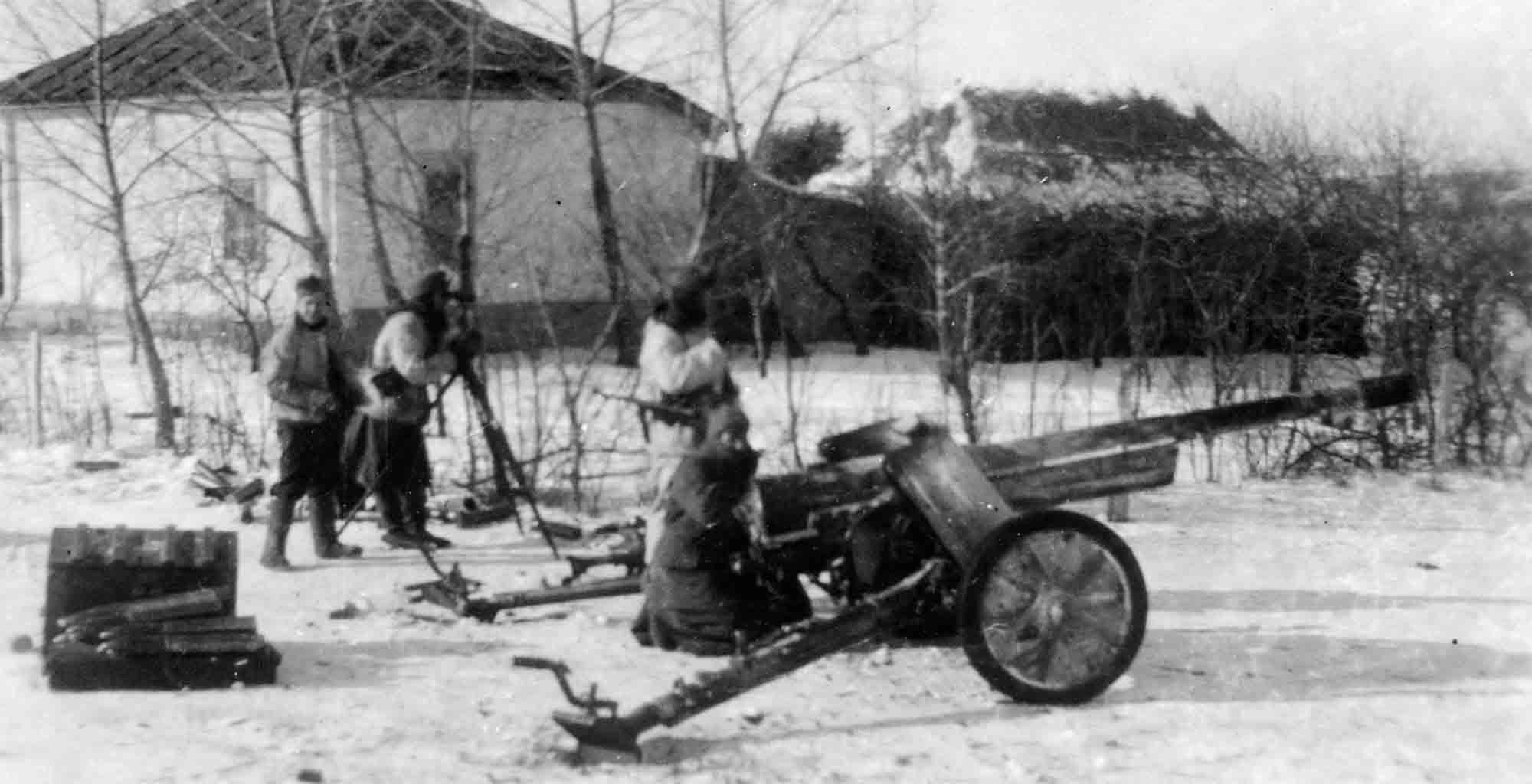

Two photographs showing the 7.5cm PaK 97/38 during winter operation. In the field these guns were still being extensively used. However, in spite of their vast array of anti-tank guns, the Germans found themselves hard pressed against modern Soviet armour.
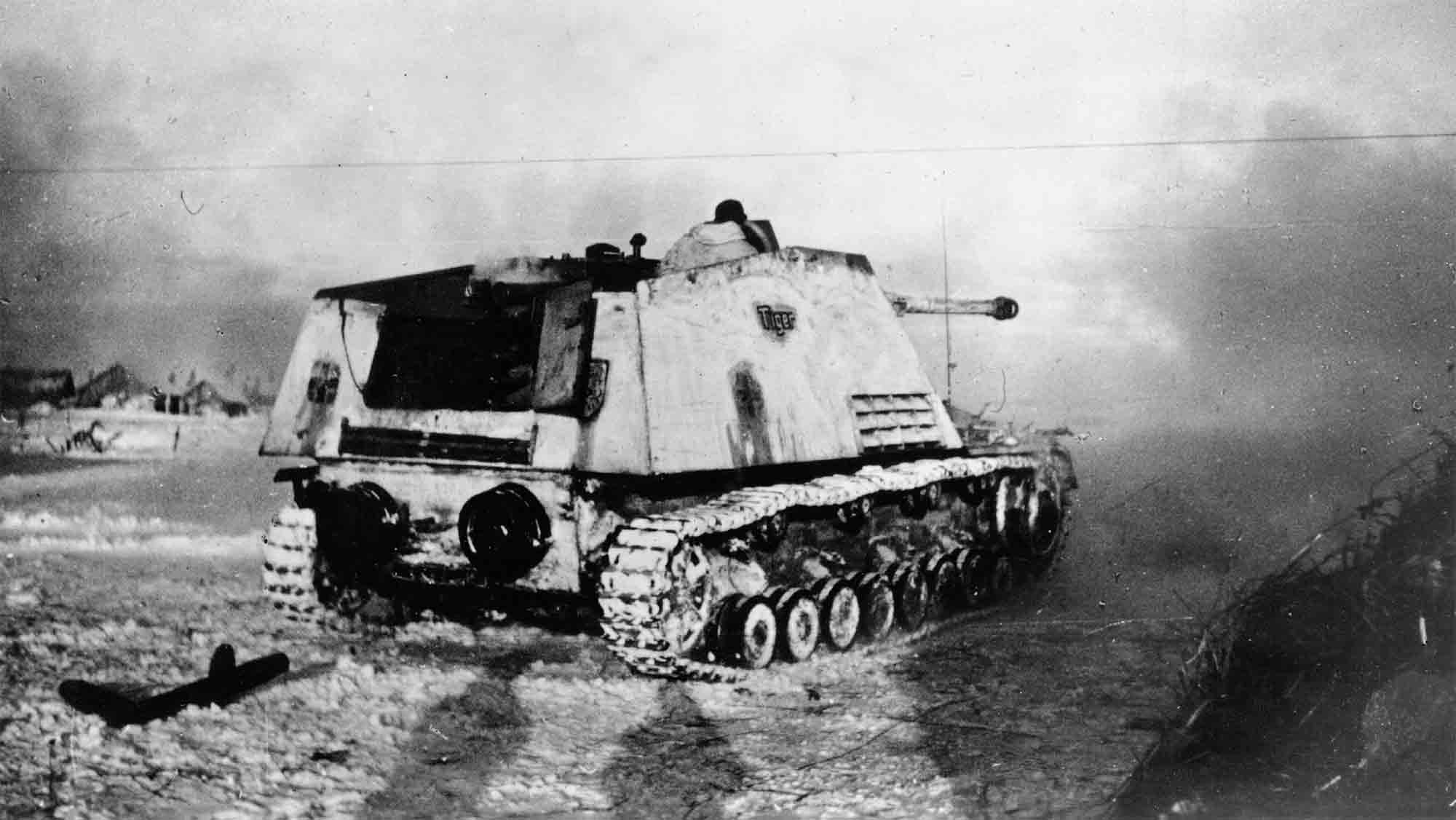
On a fire mission is the Nashorn or rhinoceros. The Nashorn looked similar to the Hummel, but unlike the Hummel this light turretless vehicle mounted a lethal PaK 43 heavy anti-tank gun. The Nashorn entered production in early 1943, and during a period of transformation it was given numerous designations, such as 8.8cm PaK 43 (L/71) auf Fahrgestell Panzerkampfwagen III/IV (Sf) or 8.8cm PaK 43 (L/71) auf Geschützwagen III/IV (Sd.Kfz.164), and it was also designated as Panzerja¨ger Hornisse (hornet). Much hope was hinged on the success of these new modified anti-tank vehicles to support the panzer and infantry during the German summer offensive in 1943.

During a fire mission a gun-loader can be seen preparing to ram another round into the breech of this 7.5cm PaK 97/38 during winter operations on the ‘Ostfront’ (Eastern Front). Behind him another crewman holds another round at the ready. Note how the gun’s position has been concealed with stacked straw.
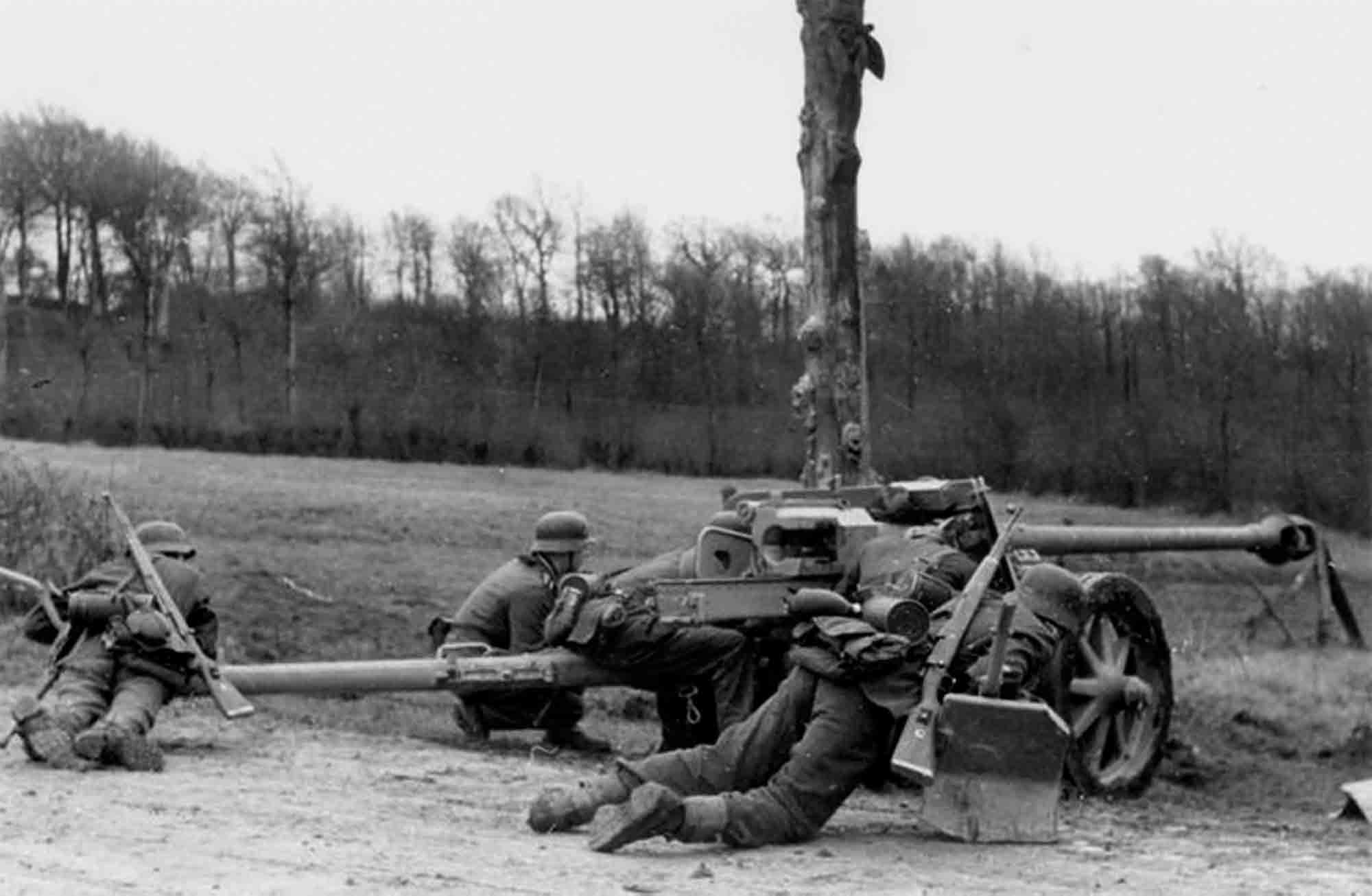
A 7.5cm PaK 40 crew preparing their weapon for a fire mission in March 1943. While this gun proved a powerful and deadly weapon, especially in the hands of well-trained gunners, because of its weight it did lead to instances where the crews had to reluctantly abandon their weapon.

A Waffen-SS 7.5cm PaK crew during a fire mission on the Eastern Front in spring 1943. Note the amount of spent shells on the ground, indicating a heavy contact with the enemy.

7.5cm PaK 40 gunners on a fire mission during operations in Russia. Some 20,000 of these guns were produced. By 1943 it had become so successful that it armed many of the German mid-war tank and destroyer designs, replacing the PaK 40 in the latter role.
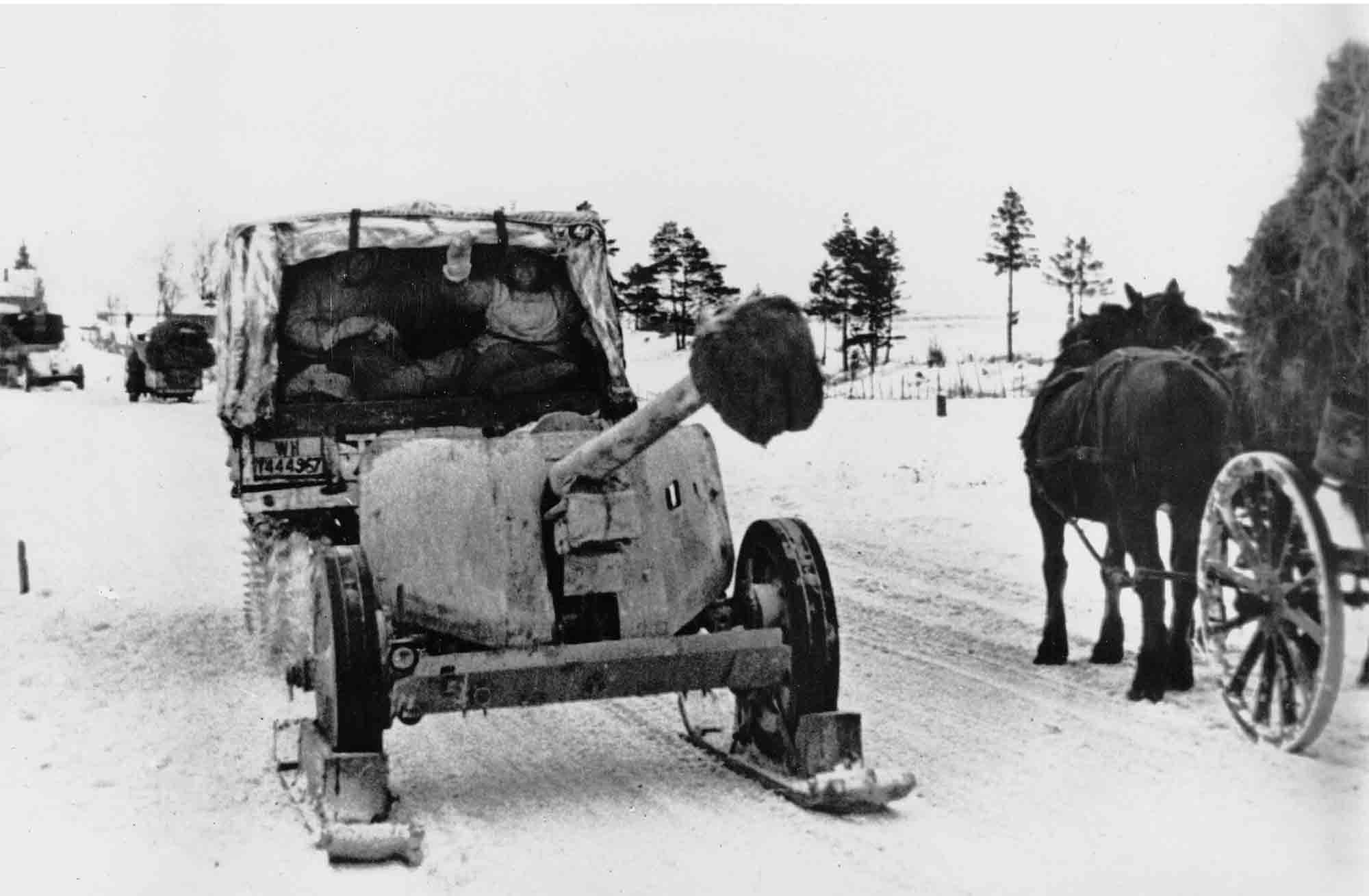
A whitewashed 7.5cm PaK 40 being hauled by a Steyr-built RSO tractor. Note that the weapon has been placed on sled-like skids under each wheel for the gun to travel unhindered across the snow.

A whitewashed 7.5cm PaK 40 is being moved into position for a fire mission against an enemy target. Crews did not find the PaK 40 easily manoeuvrable especially when they had to quickly move it from one firing position to another. This was more difficult still in mud or snow.

Positioned at the side of the road in a field is a 7.5cm PaK 40 gun crew. One of the gunners surveys the terrain ahead through a pair of 6630 Zeiss binoculars trying to assess the location of the enemy. Two of the men wear the waterproof Zeltbahn.

The crew of this Marder III Panzerja¨ger pose for the camera. This vehicle is fitted with a captured 7.62cm Soviet Model 36 anti-tank gun. The vehicle also had a travel lock on the front of the hull to secure the huge PaK barrel while travelling long distances. Some 418 of these variants were built in 1942 and were used as mobile anti-tank vehicles.
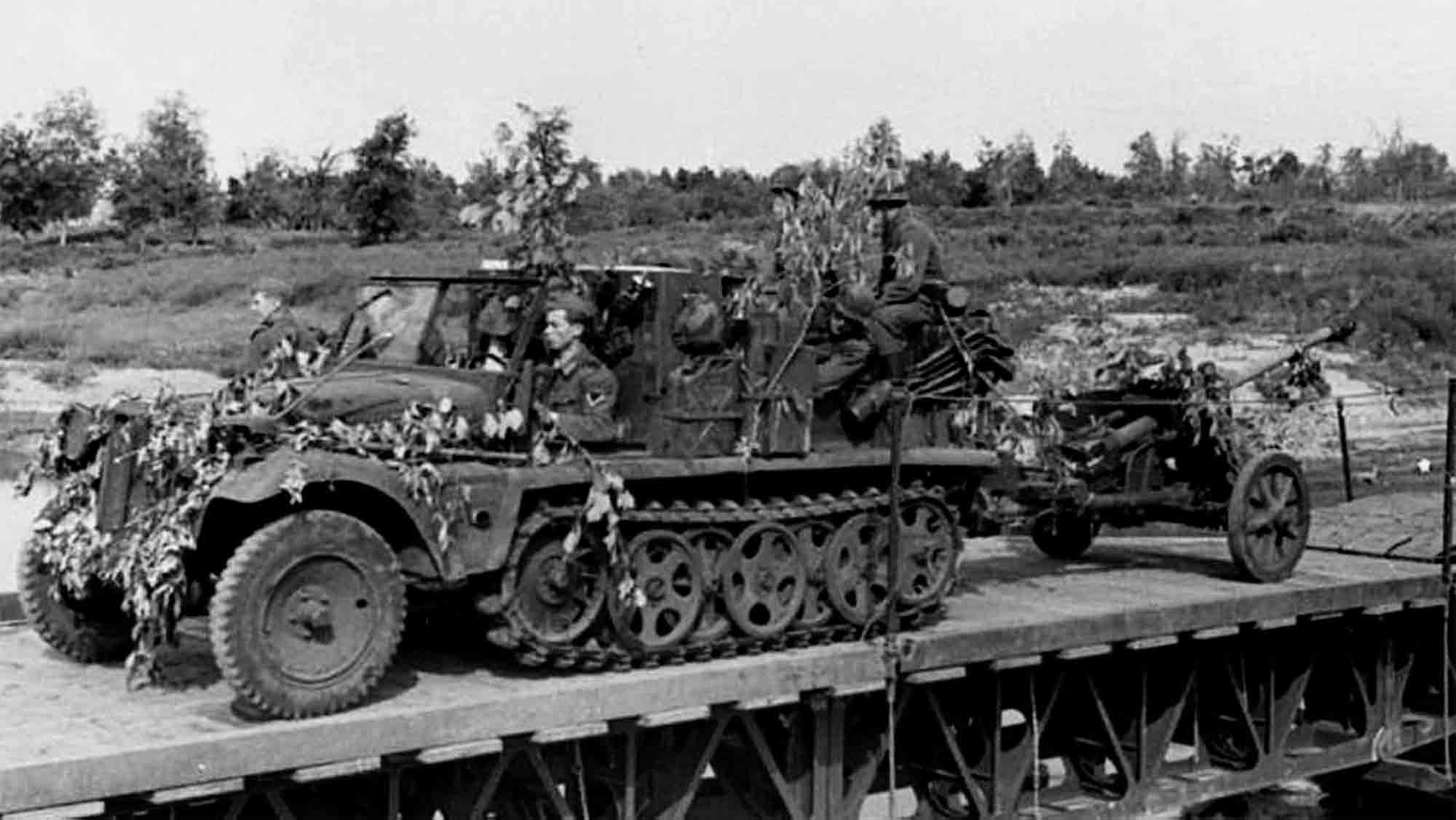
An Sd.Kfz.10 towing a PaK 38 L/60 is crossing a pontoon bridge on the Eastern Front.

An Sd.Kfz.251/22 Ausf.D can be seen mounting a PaK 40 in field during operations in Russia.
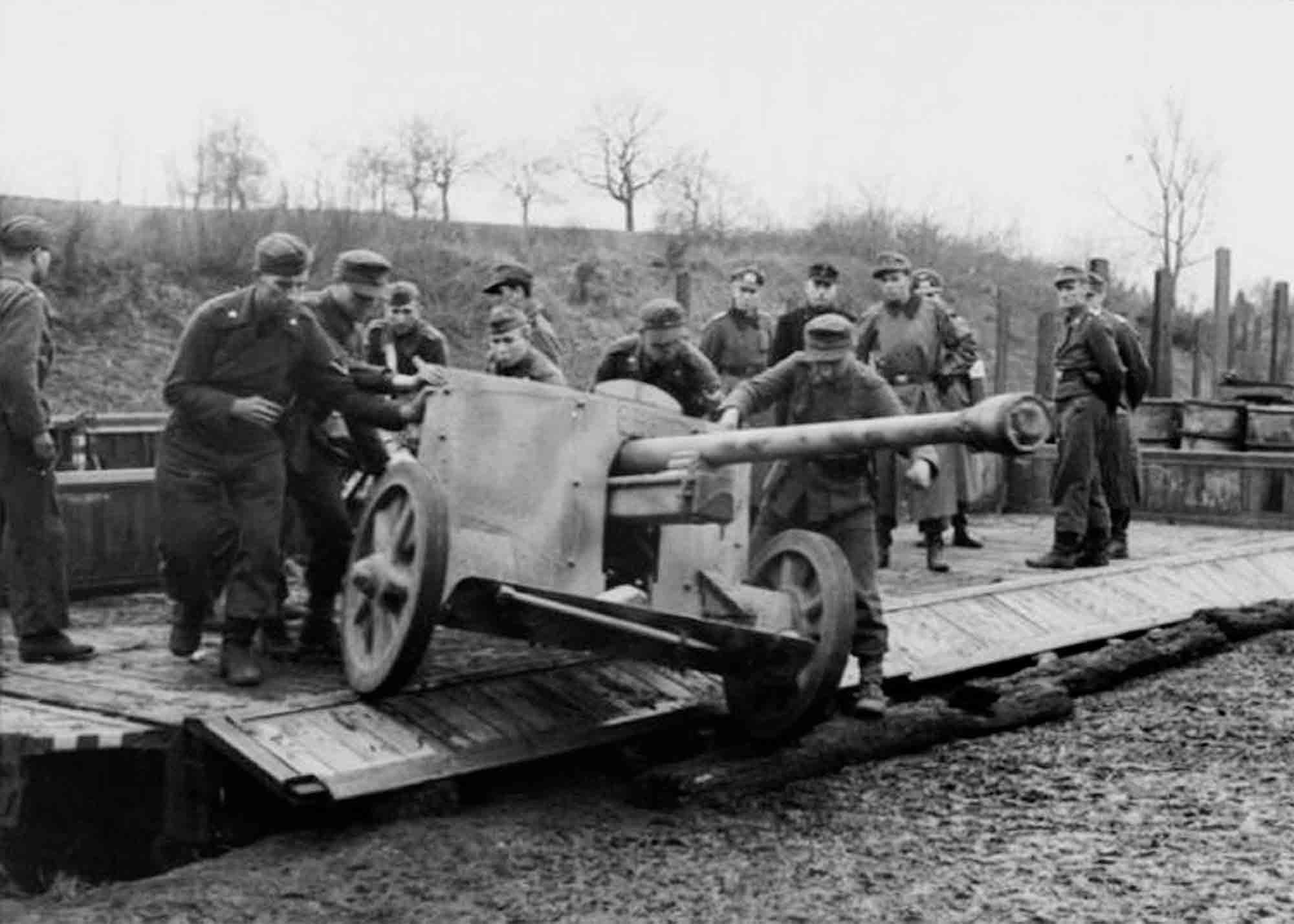
A 7.5cm PaK 40 gun crew are seen unloading their weapon from a special flatbed rail car during operations in Russia in 1943.

A well camouflaged PaK gun during operations on the Eastern Front in 1944.
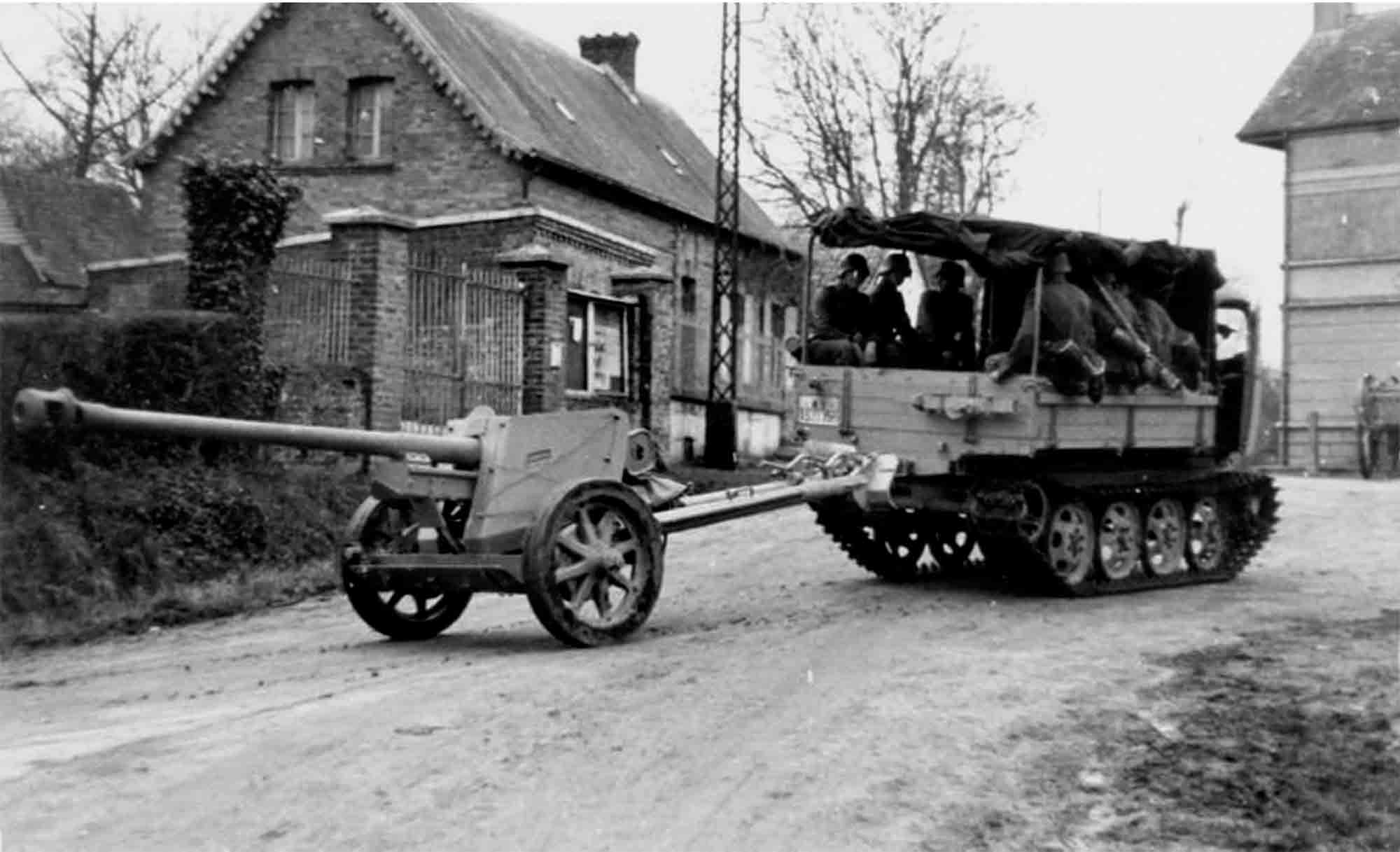
A PaK 40 being hauled by an artillery tractor to another position in 1943. The gun with its L/46 barrel had a larger double-baffled muzzle brake. The gun was well designed with its sliding breech block mechanism built horizontally which allowed for a rapid fire rate.

During the battle of Kursk in the summer of 1943 a 7.5cm PaK 40 can be seen well sited and concealed in a field. By the appearance of the gun team, they are preparing their weapon for a fire mission.

During operations on the Italian Front in 1943 is a well camouflaged 7.5cm PaK 40 being prepared for a fire mission. By this period of the war this weapon had become the backbone of operations against enemy armour.
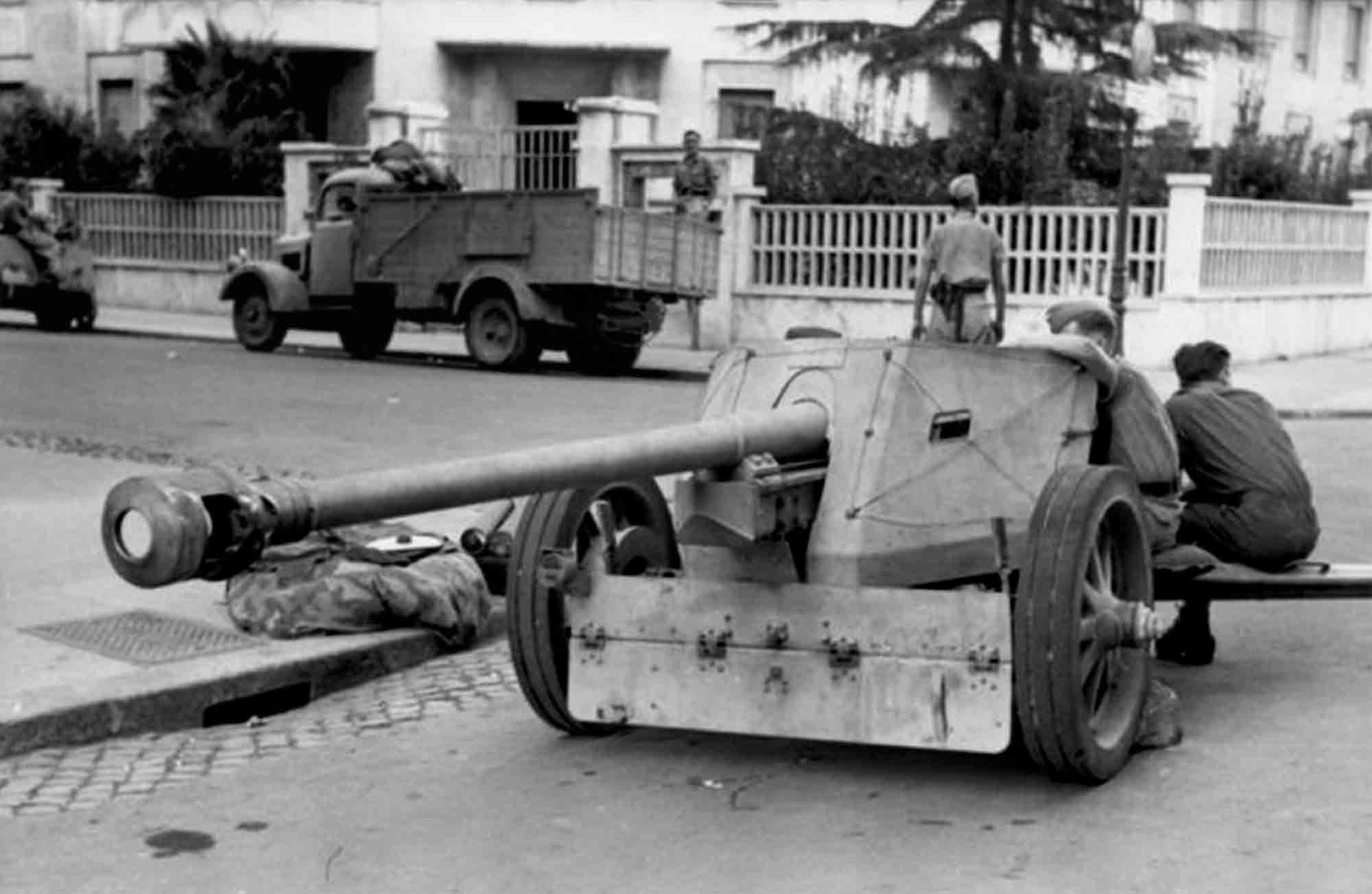
A 7.5cm PaK 40 gun crew have positioned their weapon in an anti-tank road block during fighting in an Italian town in 1943. This weapon was effective against almost every Allied tank, only struggling to penetrate heavier vehicles such as the Russian IS tanks, the American M4, M6, and later variants of the British Churchill. The PaK 40 was much heavier than the 38 and crews, especially with the terrain in Italy, found it difficult and sometimes impossible to move it without an artillery tractor.

The crew of a 7.5cm PaK 40 are preparing their weapon for a fire mission on the Italian Front. Note the projectiles primed and ready for action. Unlike the PaK 38, the PaK 40 allowed a larger charge to be used and a higher velocity for the PzGr 39 armour-piercing shells, which could easily penetrate most enemy tanks.

During summer operations this Panzerja¨ger Marder I Sd.Kfz.135 is seen operating in the field in 1944. This converted anti-tank vehicle is armed with the 7.5cm PaK gun. Most of the Marder Is were mounted on the base of the Tracteur Blinde 37L (Lorraine) French artillery armoured personnel carrier of which the Germans captured 300 following the capitulation of France in June 1940. The vehicle is easily distinguishable from the Marder family by its distinctive French wheel arrangement. As with the other Marders it mounted a high box-like thinly-armoured open-topped superstructure that sloped to the rear. The 7.5cm PaK 40 was mounted with its front shield fitted directly over this superstructure frame. The long overhanging cannon also required a gun cradle bolted onto the front hull.
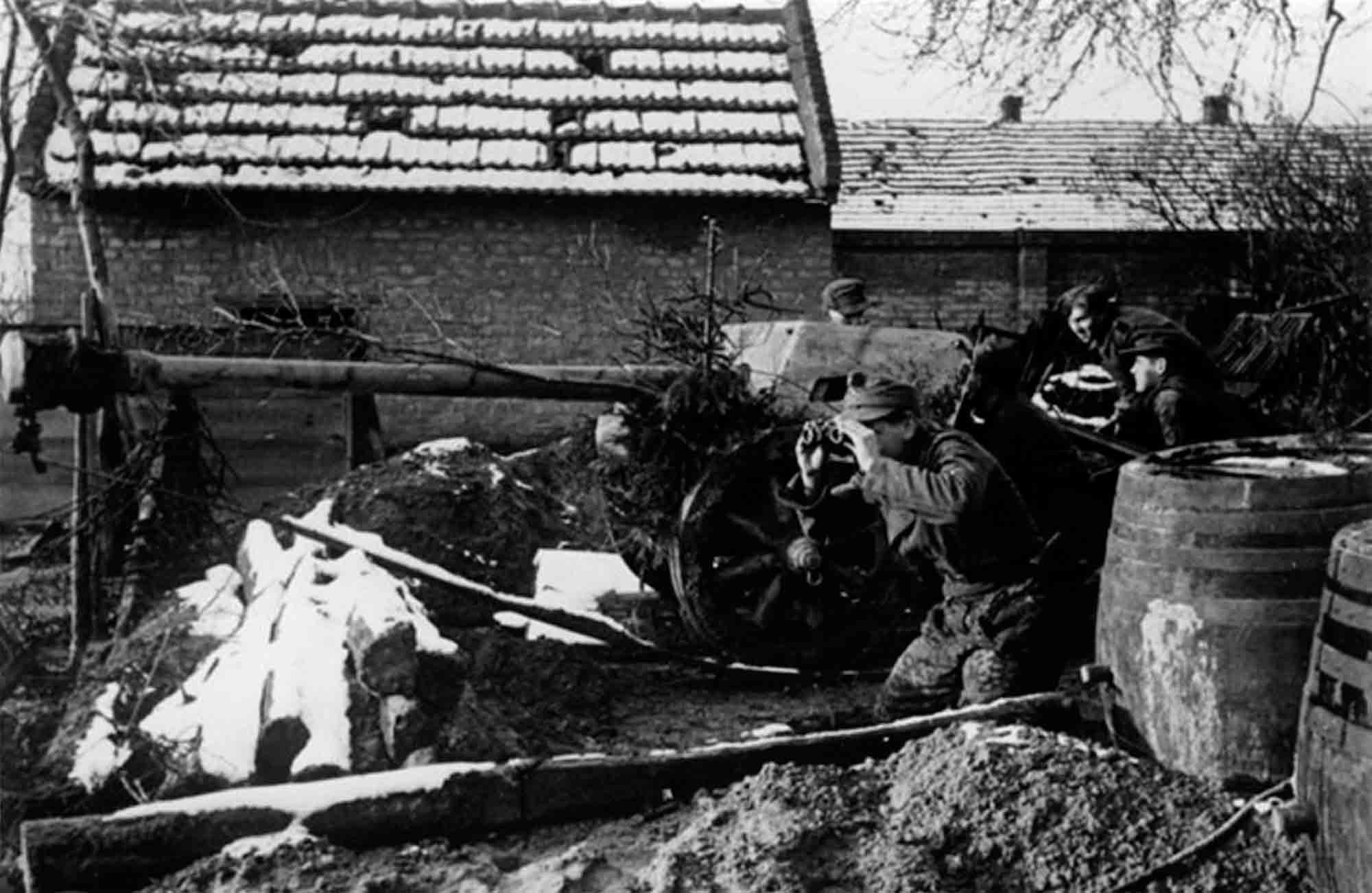
PaK gunners have moved their weapon into a well concealed position waiting for approaching armour. Note one of the gunners surveying the terrain ahead trying to locate the enemy.

Abandoned in the snow is a French-built Lorraine 3L with a PaK 40 on tow.
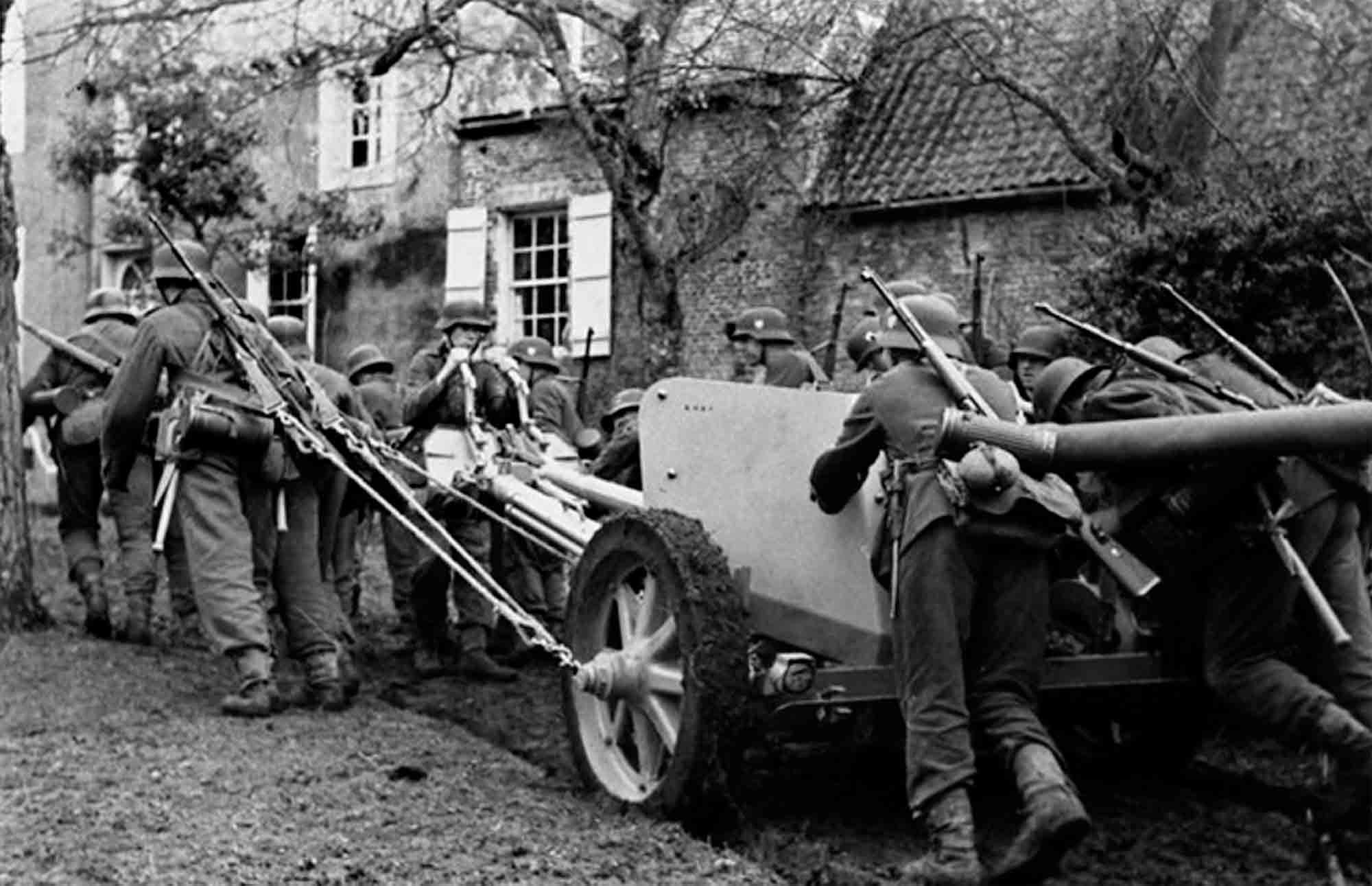
An interesting photograph taken during operations in Italy showing gunners and troops hauling a 7.5cm PaK 40 to another position. The weight of this gun can be well imagined by the number of soldiers required to move it.

A PaK 40 being hauled to the front during operations in Italy in 1943. During the Italian campaign this gun went on to be the most widely used and successful anti-tank gun. However, production was limited by critical shortages of metal.

This 7.5cm PaK97/38 is being readied for a fire mission during the Italian campaign in 1943. The gun had good mobility and sufficient anti-armour performance with a HEAT shell which was good enough to penetrate most Allied vehicles. The gun was a very capable anti-tank weapon, but it had low muzzle velocity meaning that it had to get nearer to its target before firing.

A 7.5cm PaK 40 being prepared for action during operations on the Italian Front in 1943. Note how concealed the gun is. The crew have used foliage over the gun carriage and barrel to hide it in the undergrowth.
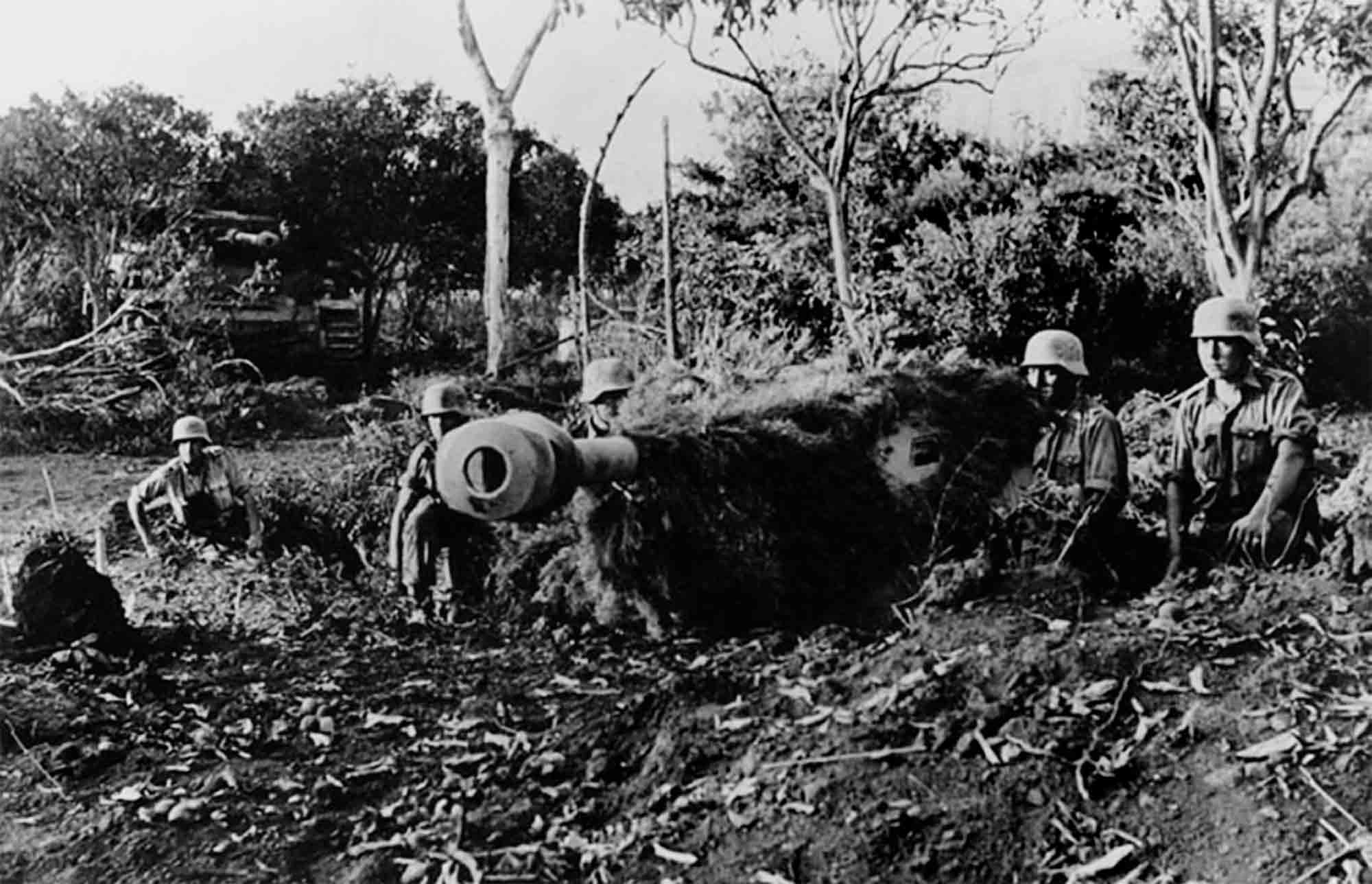
An excellent photograph showing a well camouflaged 7.5cm PaK 40 and its crew waiting for enemy armour to approach. Note the Pz.Kpfw.IV hiding in the background. Often tanks would advance to contact the enemy to draw them out into action into what was known as an anti-tank screen, commonly called a ‘PaK Front’. The tank would often duel with the enemy tank, or it would wait and let the PaK gunners attack leaving the tank to draw off more enemy armour.

In a field in 1943 during operations in Italy is a 7.5cm PaK 40 gun crew. In an offensive role this gun proved its worth, but in a defensive position crews would often find themselves being overrun as their personal weapons were minimal.
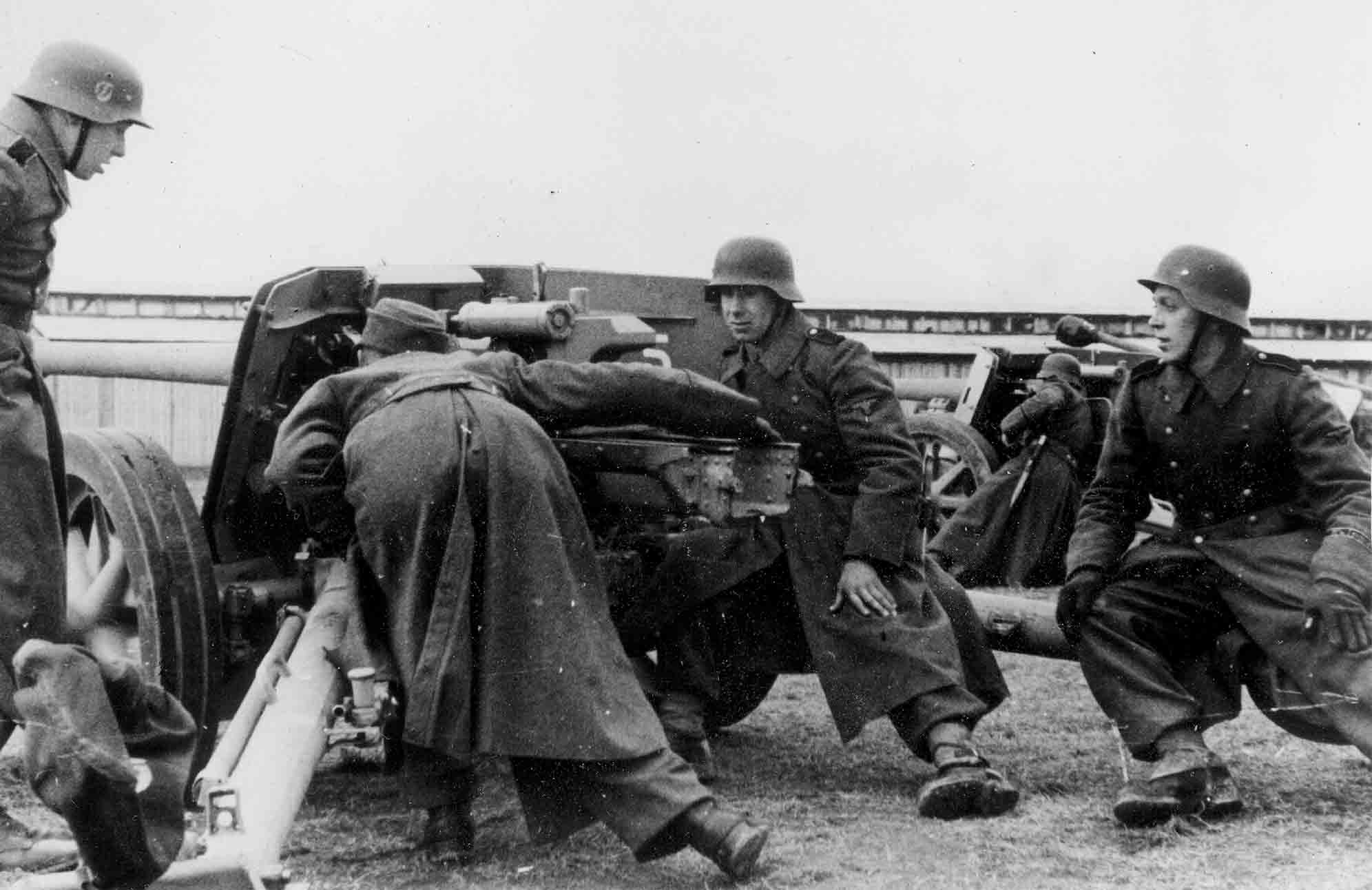
Waffen-SS PaK crews at a training ground in 1943. These gunners would soon strike fear into the hearts of their opponents on all fronts. Often clad in their trademark camouflaged uniforms and displaying an unmatched tenacity and zeal they would become dangerous opponents with their anti-tank guns in both attack and defence.

During preparations in northern France along the Normandy coast is a concealed FlaK 8.8cm with its barrel in a horizontal position for firing against ground targets. Note the FlaK gun crew, all of which have stripped down to their underwear in the heat of the summer day. However, they are all wearing their helmets.

A PaK 35/36 anti-tank gun crew can be seen moving their weapon from one position to another during preparations in the Normandy sector of France in May 1944.
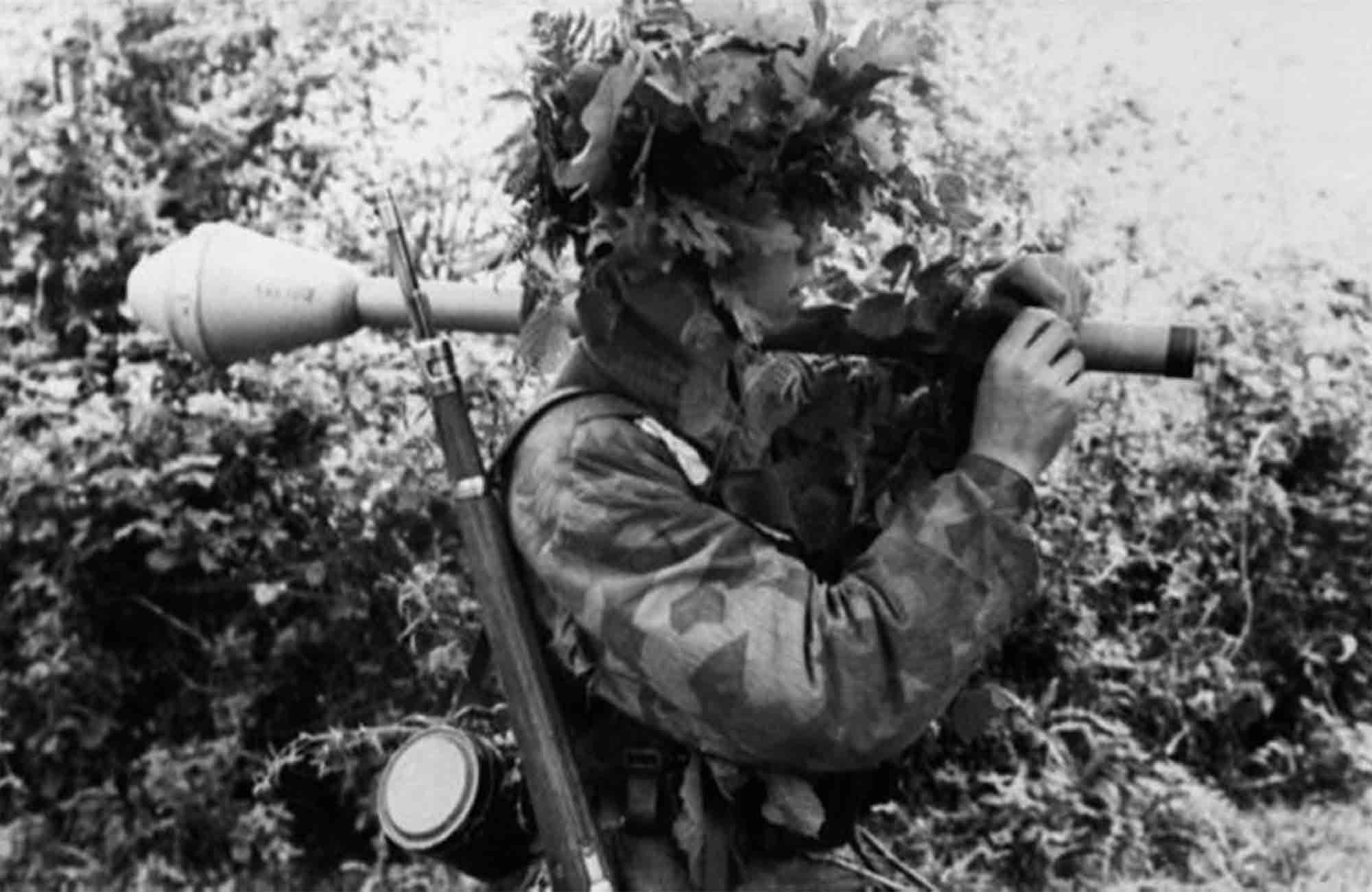
Here is well camouflaged grenadier armed with a Panzerfaust on the Western Front in 1944. During the German retreat through France grenadiers put up stiff resistance with defensive lines. Along these lines were heavy machine gun platoons dug in holding each end of the line with crude obstacles erected. Troops were emplaced in defensive positions armed with a motley assortment of PaK and FlaK machine guns, Panzerfaust and Panzerschrek.

Grenadiers on the march through Holland in September 1944. Some can be seen armed with the Panzerfaust. By this late period of the war there was a dramatic increase in the loss of Allied tanks to the Panzerfaust: more than half of the tanks knocked out in combat were destroyed by Panzerfausts or Panzerschrecks.
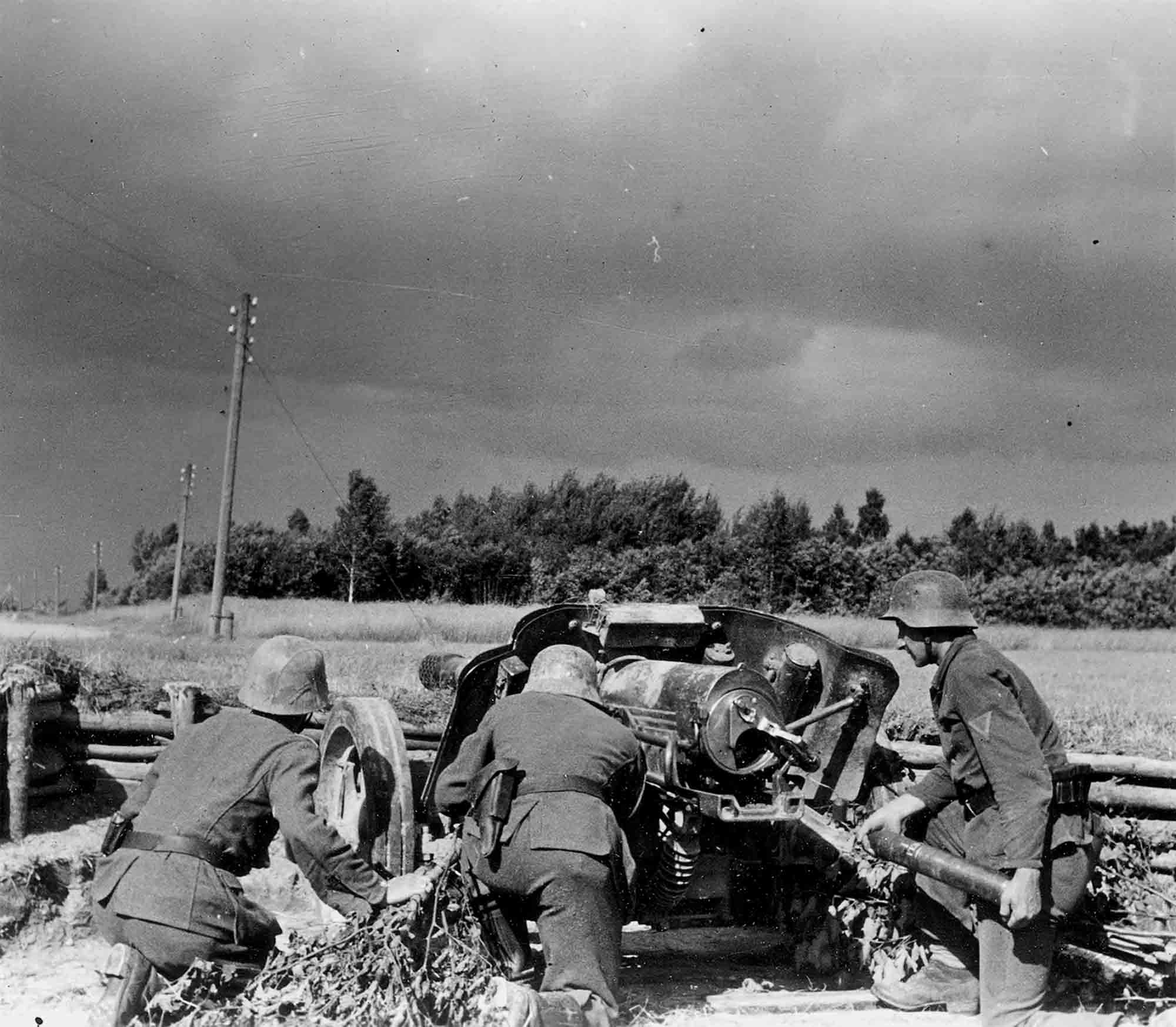
The crew of a well positioned PaK 97/38 preparing for a fire mission against an enemy target. This weapon reached the battlefield in the summer of 1942. Despite moderate effectiveness and an aggressive recoil, it remained in service until the end of the war. The gun was used extensively: some 37,800 HEAT shells were produced in 1942 and a staggering 371,600 by 1943.

A typical scene for PaK gunners during operations. Often PaK gunners would move their weapon onto roads to block oncoming enemy armour. They would destroy anything that moved on or across the road.
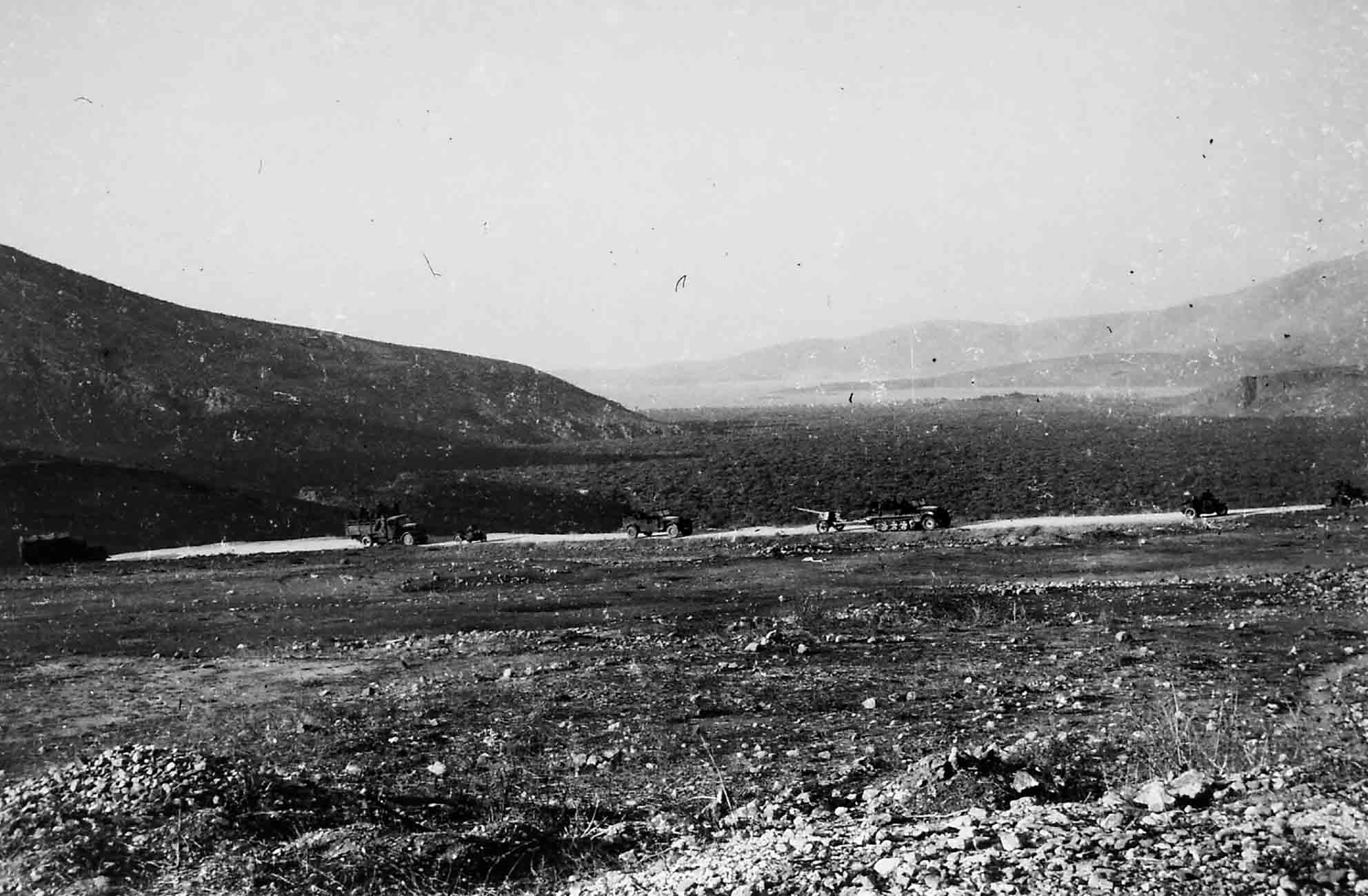
A column of vehicles in the Balkans, more likely an anti-partisan operation. A gun, which appears to be either a PaK 38 or 40, is being hauled by a halftrack Sd.Kfz.10.

A photograph the moment this PaK 40 is fired during an attack against an enemy target. The noise of the blast is evident by one of the gunners plugging his ears. This weapon has been positioned in a field and is well camouflaged.
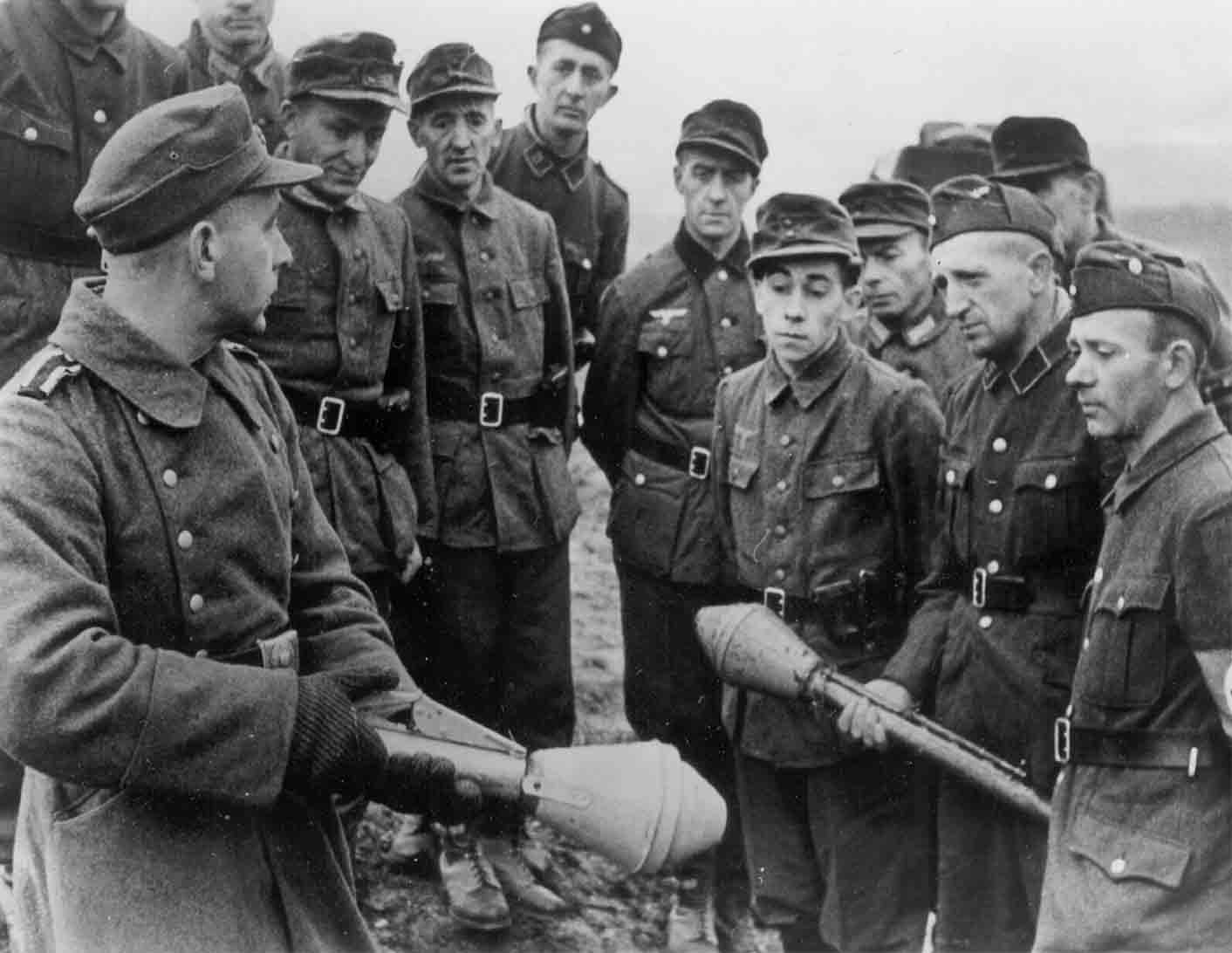
An interesting photograph showing Finnish troops undergoing training with the Panzerfaust 60 (left) and 30 (right) by a German Unteroffizier. The numbered Panzerfaust indicated the approximate effective range in metres. However, the Panzerfaust 60 actually had a maximum range of 80m, which was acceptable for a hand held anti-tank weapon.

Another photograph showing Finnish troops being trained to use the Panzerfaust. This particular weapon is the Panzerfaust 30, which the Finns called the ‘Panssarikauhu’. During the war Finnish troops used the Panzerfaust more than any other nationality except Germans.
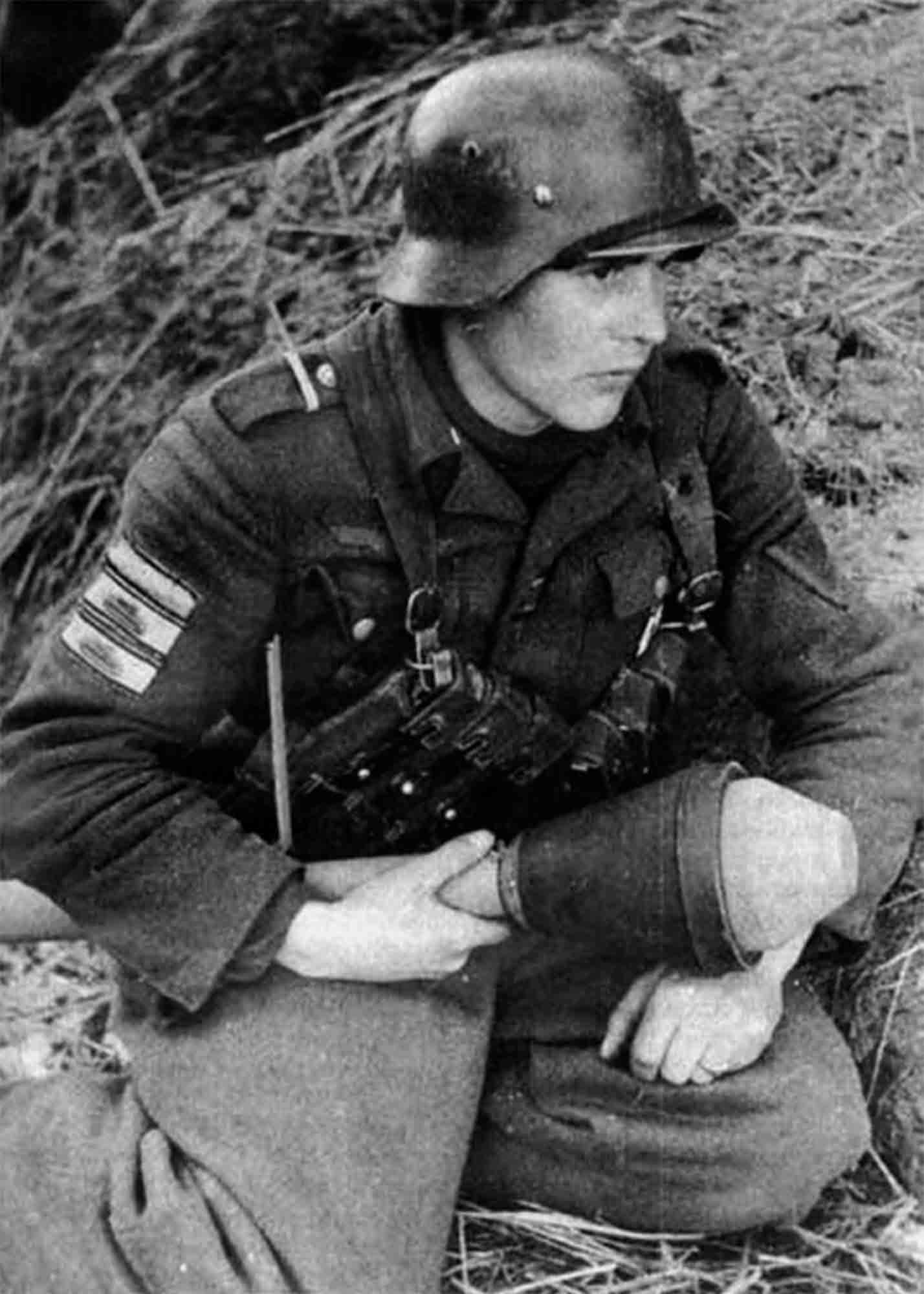
A young assault gun grenadier armed with his Panzerfaust during operations on the Eastern Front. Note special award badges stitched to his tunic upper arm for close combat of a tank or single combat. On the Panzerfaust firing instructions a back-blast warning was stencilled in black on the sides of the dark yellow launcher tubes. Sometimes instructions were printed on a black on white paper label which was stuck on the lower part of the warhead body.

Grenadiers are seen on a road preparing what appears to be an anti-tank road block. They are all armed with the Panzerfaust 30 anti-tank gun. Some wear a mosquito net pulled over their helmets to combat the flies and mosquitoes that often plagued the Eastern Front especially in swampland areas.
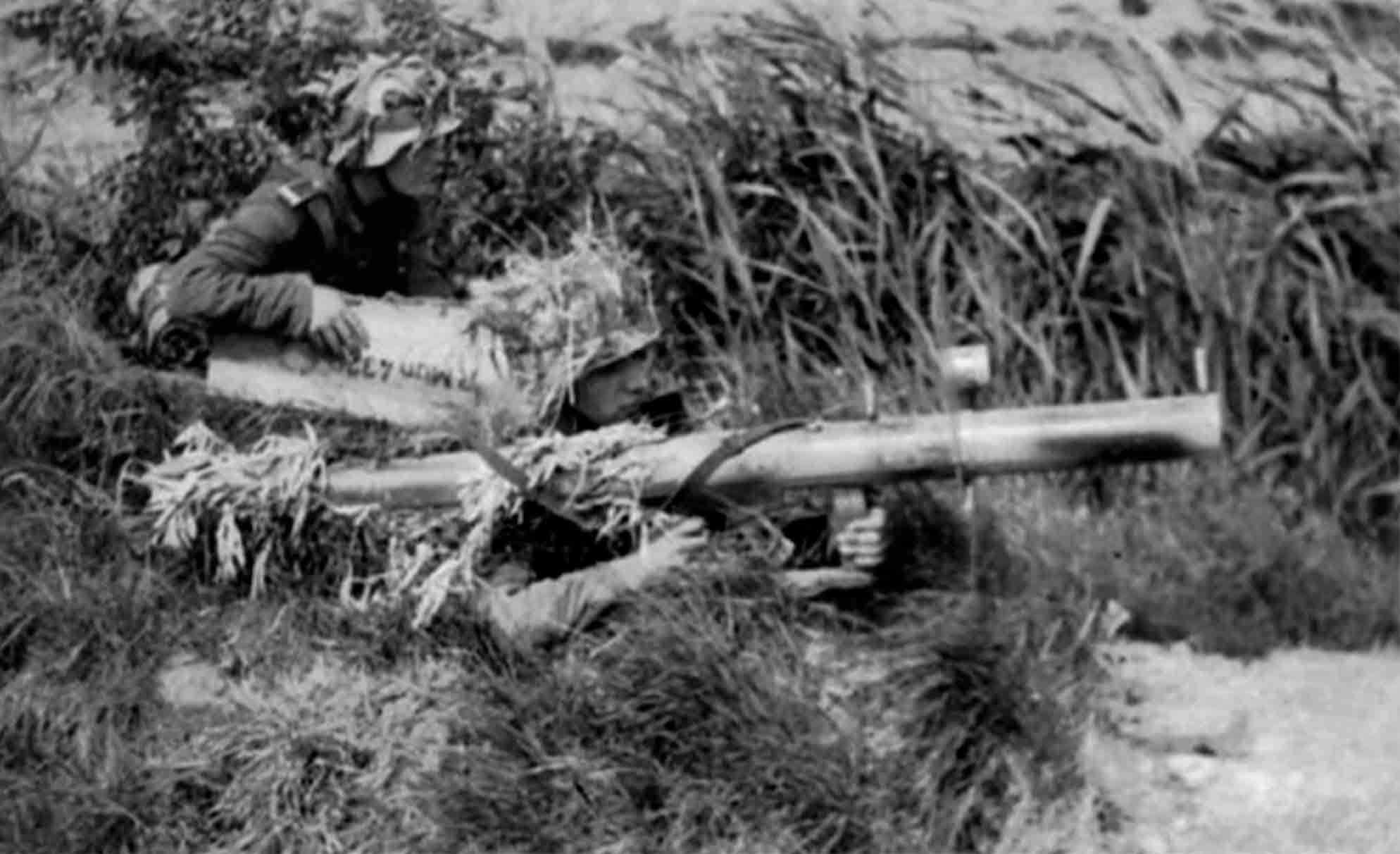
A well camouflaged grenadier armed with the Panzerschreck or Raketenpanzerbüchse 54. The RPzB 54 was a hand-held 8.8cm reusable personnel anti-tank rocket launcher. Another nickname was the ‘Ofenrohr’ (stove pipe) because it produced a lot of smoke on firing. The Panzerschreck was designed as a lightweight disposable infantry anti-tank weapon and was an enlarged copy of the American bazooka. It was shoulder-launched and fired a fin-stabilised rocket.

During a lull in the fighting on the Eastern Front are PaK gunners resting in a field. On the battlefield the Germans found both the PaK 38 and 40 valuable. Russians who captured them, however, found them heavy and difficult to manoeuvre.
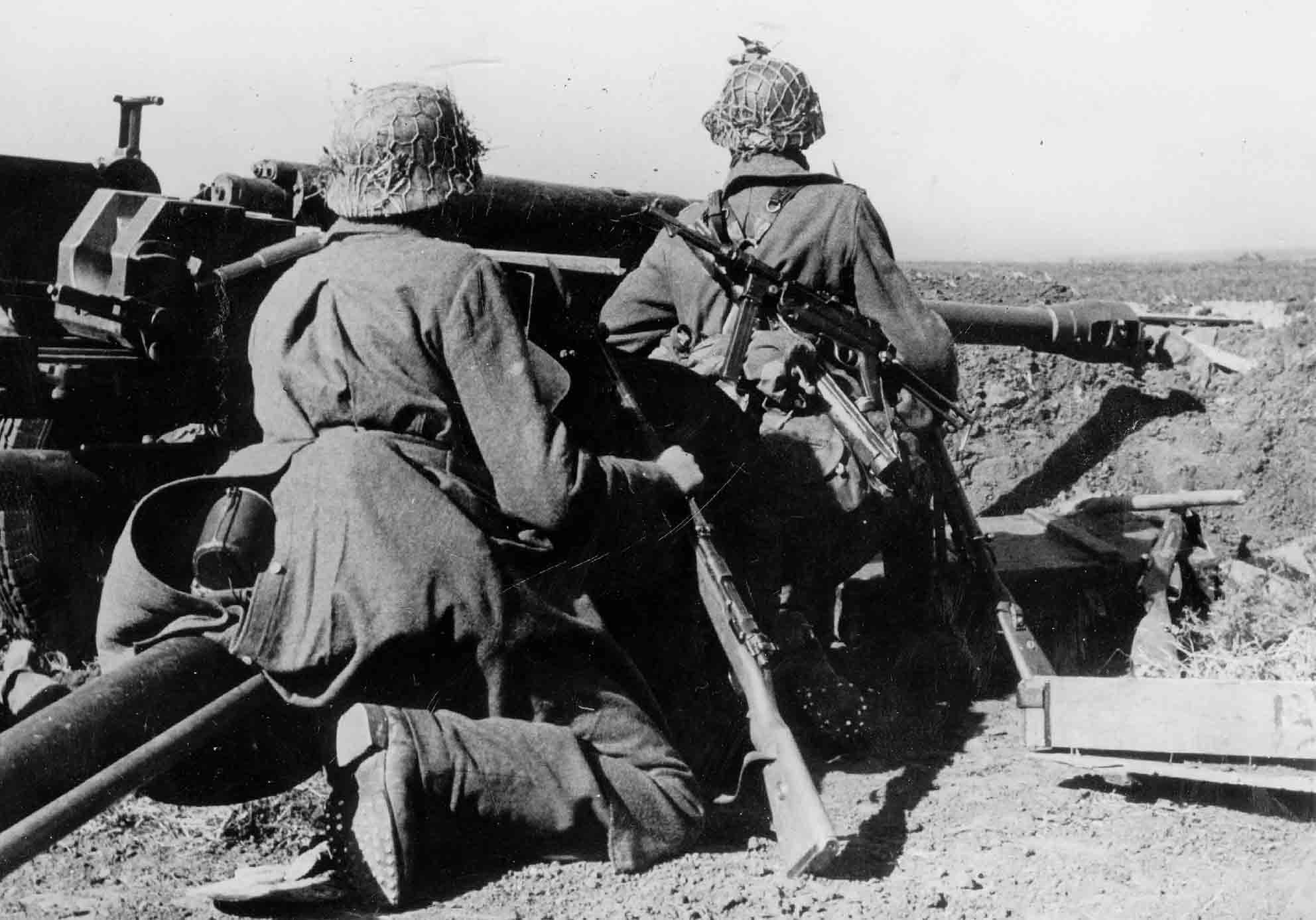
Another way to conceal an anti-tank gun in the open was digging a hole or trench so that the barrel of the gun was almost level with the ground. This not only hid most of the gun including its distinctive wheels but also protected the crew from enemy fire. Note how well this PaK gun has been hidden.

The most powerful anti-tank gun to see service was the PaK 43. Here in this photograph the PaK 43 is being hauled by an Sd.Kfz.7 on a road somewhere on the Eastern Front. The PaK 43 saw service in significant numbers, also serving in modified form as the 8.8cm KwK 43 gun on the Tiger II, the open-top Nashorn, Elefant and Jagdpanther tank destroyers. This improved 8.8cm gun was fitted with a semi-automatic vertical breech mechanism which greatly reduced recoil. It could also be fired electrically while on its wheels. The gun had exceptional penetration and could destroy the frontal armour of any enemy tank even at long range even the Soviet IS-2 tank and IS chassis-based tank destroyers.

With the drastic need for more anti-tank guns the Germans often created hybrid pieces of ordnance. One such gun married the gun tube of the 8.8cm PaK 41 to the carriage of the 10.5cm IeFH 18. Sometimes these guns were mounted onto the wheels of the 15cm sFH 18. A newly designed splinter shield was bolted onto the carriage and from this the PaK 43/41 was created. In this photograph the PaK 43/41 is being moved by gunners to another position on the Western Front. The 43/41 proved heavy and cumbersome to handle, especially on uneven terrain or in the mud and snow. Gunners often referred to this weapon as the ‘Scheunentor’ (barn door) due to the size and weight of its gun. Despite this it was an effective weapon on the battlefield and scored many success on all fronts.

A Ferdinand Elefant Panzerja¨ger has halted inside a Russian village in 1944. The Elefant was fitted with the powerful anti-tank 8.8cm Panzerja¨gerkanone 43/2 gun (early designation 8.8cm StuK 43/1). Ninety-one of these Panzerja¨gers were produced by May 1943, eighty-nine of which were committed to the Kursk operation. The Panzerwaffe placed great value on the new second generation of tank destroyers, and much was expected of them during the last years of the war. The Elefant proved to be an effective and successful machine. German mobile anti-tank weapons acquired a healthy respect in the eyes of the Soviets that came up against them: Russian tank crews engaged them with caution. But production difficulties and lack of fuel were constant sources of problems.





















































